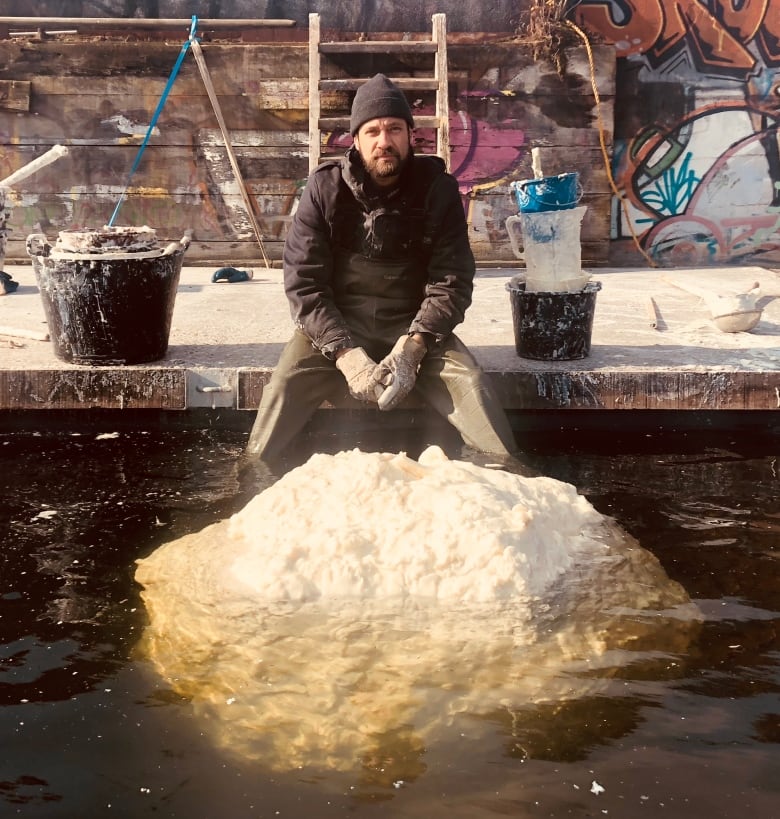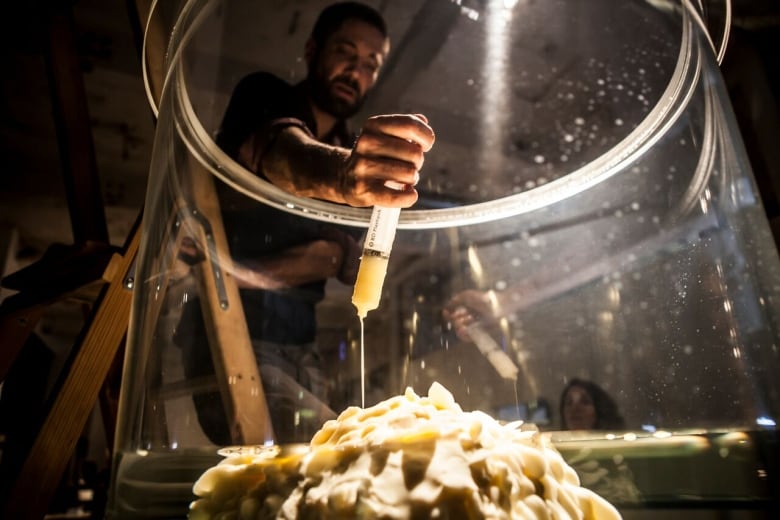By a wharf in Amsterdam, a blob of fat — weighing more than 1,000 kilograms — is floating in the water.
While just the thought of that would disgust some people, to Arne Hendriks the “floating island of fat” is “just beautiful.” He has been making Fatberg, along with fellow designer Mike Thompson, since 2014.
But don’t think of them as a pair of artists with a quirky idea. Hendriks says they consider themselves “agents” of the fatberg — which could hopefully change some people’s perspectives on fat.

Fatbergs were in the news last year, when a massive one was discovered in London’s sewer system. But unlike that fatberg, Hendriks says his creation, which is made of 100 per cent clean fat, doesn’t smell.
“The fatbergs in the sewer are not just fat, right. They are a composite of everything that floats around in the sewer … wet wipes, feces, I don’t know, all sorts of things rotting away,” Hendriks tells As It Happens host Carol Off.

The pair started making their Fatberg in a glass years ago, but it has now grown into something that Hendriks says has a circumference of around four metres.
“If you would want to give it a hug, it would look like you’re hugging — I don’t know — let’s say a giant, giant, giant snowman,” he says.
“It’s hard fat so you wouldn’t really like sink into it, unless it’s like 35 degrees celsius outside … When it gets really warm, it sort of becomes a little bit sticky. But now, it’s winter time, so it’s nice and hard and beautiful and, yeah, it’s behaving itself really well at the moment.”

Hendriks says they “don’t discriminate” about the type of fat they add to the Fatberg. They’ve used animal and plant fat, but not human.
“People have offered it, but it’s not there. You know, offering is one thing. But, you know, actually taking it out of your body, bringing it to the island, and putting it on there is quite another thing,” he says.
Hendriks says fat is misunderstood.
“I think we are not spending a lot of time with this very, very interesting material.”
He hopes Fatberg will “change [people’s] perspectives of fat, or at least their discussions around fat.”
“There’s never been more fat in the history of life on this planet, probably. So, somehow, this fat is here. It wants to be here. It wants to express itself. But it does so in very limited fashion. It does it on bodies. And it does, maybe, in the sewers of London … but it doesn’t really have its own space,” he says.
“We felt we needed … to create an autonomous, free space for fat, so we understand this material that is so iconic for our age.”
Hendriks says, eventually, they want to set their Fatberg free.
“It is a being of its own, so it gets to decide what it wants to do — of course through us because it doesn’t have legs and cannot walk away.”
One idea is to send it to the Arctic circle to “kind of symbolically replace an iceberg.” But that’s not confirmed.
Whichever way the Fatberg leaves Amsterdam, Hendriks says it will likely feel bittersweet.
“I guess it’s sort of parenthood. And I’m not even sure if we’re parents of this. Maybe it’s the parent, I don’t know,” he says. “Maybe there will be some sadness, but also pride that we actually managed to do this, I guess.”